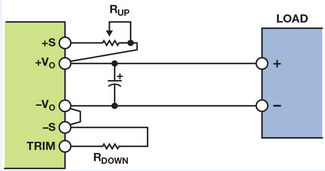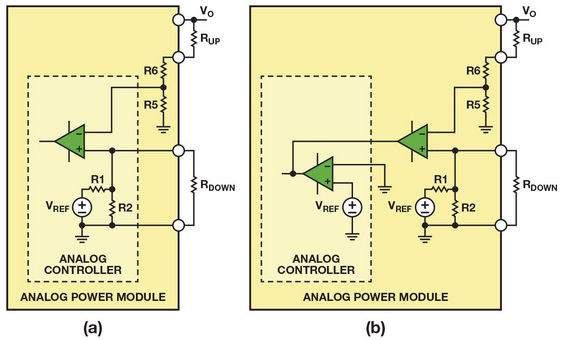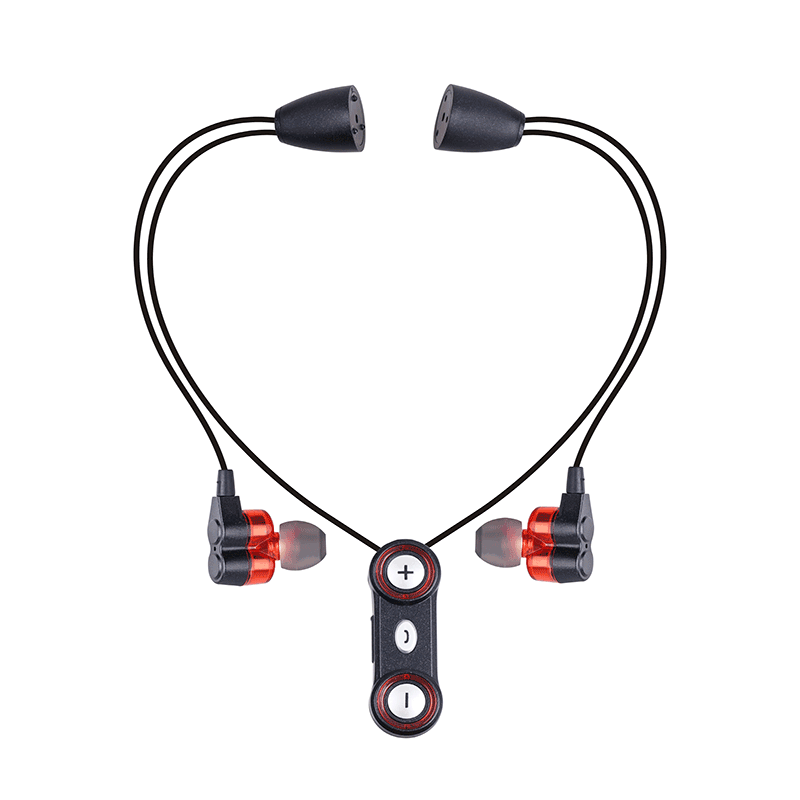Recently, the development of Very Large Scale Integration (VLSI) technology has broadened the range of digital control applications, especially in power electronic components. Digital control ICs offer several advantages, such as smaller die size, fewer passive components, and lower cost. In addition, digital control can utilize the Power Management Bus (PMBus) to complete system configuration; advanced control algorithms improve performance; and programmability enables application optimization. As digital power management becomes more popular and replaces a large number of analog controllers, it must maintain backward compatibility of existing functions so that both digital and analog power modules can operate in the same system.
Output voltage adjustment is typically used in analog power modules so that the end user can change the output voltage of the power module with an external resistor. It has increased flexibility, allowing certain selected standard modules to be used in almost any application, regardless of voltage requirements. Figure 1 shows a typical configuration for adjusting the output voltage in an AGF600-48S30 analog power module.
The output voltage can be adjusted by changing the resistance connected to the positive output or ground of the power module. By connecting the external resistor RUP and floating the RDOWN, the output voltage can be adjusted upwards (higher than the nominal output voltage) or by connecting an external resistor RDOWN. Short the RUP (zero resistance) down (below the nominal output voltage).

Figure 1. Adjusting the output voltage of the AGF600-48S30 DC-DC converter
In analog solutions, RUP and RDOWN can change the reference voltage of the error amplifier. The error amplifier uses a resistor divider to sense the output voltage, and the voltage divider is connected to the inverting input of the error amplifier via negative feedback. The output voltage of the error amplifier controls the duty cycle of the drive signal, which in turn sets the output voltage. Therefore, the output voltage changes with the change of the reference voltage, and RUP or RDOWN can change the reference voltage to adjust the output voltage up or down.
Figure 2 shows two voltage regulation methods that are widely used in analog power modules. The analog controller pin in Figure 2(a) allows the external resistor RDOWN to reduce the voltage at the non-inverting input of the error amplifier, thereby reducing the output voltage. The external resistor RUP is connected in series with the resistor divider to reduce the voltage applied to the inverting input of the error amplifier, thereby increasing the output voltage. The analog controller in Figure 2(b) does not provide access to the internal reference, but an external error amplifier and reference can be added to adjust the output voltage. The external amplifier output is connected to the internal amplifier output, effectively bypassing the internal error amplifier. Then, the reference voltage can be configured with the same circuit as before, so that the two power modules can be adjusted in the same way.

Figure 2. Using (a) an analog controller with a configurable internal reference,
Or (b) an analog controller with a fixed internal reference voltage to adjust the output voltage of the analog power module
Neck bluetooth headset - a bluetooth headset with headphone cables or accessories running from the neck to the ear when wearing. It is a product developed in recent years.
Born: in order to solve the boring when running or control the exercise rhythm, many people choose to listen to music,however, experienced people all know that because of the swing in the process of exercise, the earphones are easy to fall off, which makes it difficult to run coherently and constantly ,under this circumstance, the Bluetooth Neckband Headphones was designed.
Features:
1: There is no restrained from headphone cables.
2: In line with the development trend of headphones: From the perspective of the development trend of consumer headphones, bluetooth neckband headphones should be regarded as the general trend. Whether it is sports headset or head-worn headset, many manufacturers are vigorously developing bluetooth headset to occupy the market.
3: Not affected by audio interface
More and more flagship mobile phones are also trying to cancel the audio interface, which is the important reason for the generation of bluetooth neckband headset. As long as the device that supports bluetooth music play is ok, the audio interface will not be considered.
4: No burden when running
Sports neck hanging bluetooth headset is light and easy to wear, more convenient and fast storage, no knot, more relaxed entertainment sports, let you run zero burden.
5: Waterproof and sweat-proof are very important
When exercising, people will sweat a lot, which may cause some damage to the ears. The bluetooth neckband headphones adopts the IPX5 waterproof design, which is more suitable for sports scenes. Especially in summer, when sweat is easy to happen, it is necessary to use the bluetooth neckband headphones.

Bluetooth Neckband Headphones
Wireless Headphone,Bluetooth Headphones Wireless,Bluetooth Headphone Neckband,Neckband Bluetooth Headphones
Shenzhen Linx Technology Co., Ltd. , https://www.linxheadphone.com
